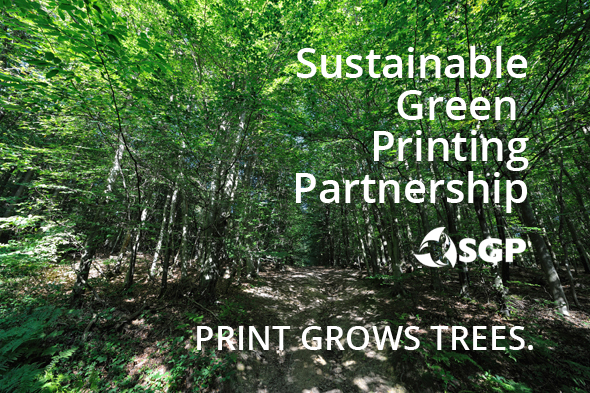Green, Sustainable, Earth-Friendly

Really? Better Take a Closer Look.
For those of us in the Graphic Arts Industry, SGP Sustainable Green Printing Partnership has taken all the guessing out of green. Established in 2008, this organization has taken a magnifying glass and reviewed all aspects of the printing industry. “You have been tried, reviewed, and in many cases found wanting.” If your supplier is not SGP Certified by the Sustainable Green Printing Partnership, the business most likely is not operating sustainably yet, even if Green is in their name!
Recycling Paper?
What is true sustainability in the print and graphics arena? There are many processes, new technologies and new consumables that define and make for a truly green print process. While outdated equipment, antiquated technologies and old processes often pack a toxic punch. SGP helps a business review itself in light of environmental sustainability from all aspects, including human resources. What is your carbon footprint? With a little process change and minor investments, often a business specializing in print services can proudly claim green product and process. We have even experienced new cost efficiencies with some process changes. A little extra cash in the long run always brings a smile.
Using Recycled Content papers? Again, beautiful, but give credit where credit is due. U.S. mills have truly stepped up, cleaned up their act, and are producing a great variety of beautiful papers that contain post-consumer waste. Buying papers from U.S. mills ensures the wood pulp is responsibly sourced. It comes from local farmed tree sourcesnot national forests or old growth, destroying critical habitat. It is a controlled supply chain in which everyone benefitsincluding Mother Earth. Everyone in the stream of the supply chain from land-owners and farmers to consumer can make sustainable choices. This provides jobs for many people across the country. Pulp and paper mills (107,630 jobs as of January, 2014), designers (95,180 jobs, 2009), printing (441,100 jobs, 2013) according to the Bureau of Labor Statistics. The recycling industry (1.1 million jobs by U.S. EPA).
Did you ever white wash a fence? It is a process of covering up what looks bad, and making it look very presentable. The equivalent in ecological vernacular is Green Washing. It is great to recycle, use recycled content paper and to print with soy inks. Very admirable. However, if equipment is antiquated, not well maintained, drips contaminated water down a drain, or releases VOC toxins out the vents, using recycled paper does not make a company green. Dated processes often use chemicals that are a health risk to employees. Green Washing is touting environmental responsibility such as recycling and yet operating with equipment or processes that endanger employees or the environment. It is critical to hold businesses, vendors and suppliers responsible for impact that the business has on our environment.
In the Graphic Arts Industry, it is the mission of SGP Sustainable Green Printing Partnership. It is all about helping companies recognize where they need improvement and to set goals to continually become better stewards of our environment.
“The Mission of SGP is to encourage and promote participation in the worldwide movement to reduce environmental impact and increase social responsibility of the graphic communications industry through certification and continuous improvement of sustainability and best practices within manufacturing operations.”
Support companies in the Graphics Industry that are SGP certified green. Encourage your service provider to become certified by SGP. Champion your corporation or business to add SGP criteria to procurement criteria. Challenge your community to choose a green printing process. A little change by many makes a great difference.
Fun Facts:
- The U.S. has 20% more trees today than on the First Earth Day in the spring of 1970.
- Paper Grows Trees. Trees are the primary source for paper pulp. Trees are a renewable resource. Choose U.S. papers which come from well-managed forests or farms.
- Paper protects lands? Farmed trees provide income to landowners which helps to pay taxes. This reduces land sales to developers.
- In Europe and the U.S. approximately 60% of energy used in making paper comes from renewable resources.
- Printed products are renewable. Recycled and repurposed paper re-enters as a new product. 63.6% of paper consumed in the U.S. is recovered for recycling.
- Direct mail is about 2.4% of municipal solid waste.
- Electronics total about 2.37 million short tons of waste.
- A newspaper decomposes in a landfill in 2–4 weeks.
- An apple core decomposes in a landfill in 1-2 months.
- Milk Carton: 5 years.
- Plastic milk jug: 500 years.
- Decomposition of Plastic bags & bottles: 100’s of years.
- Cigarette butt: 1-5 years.